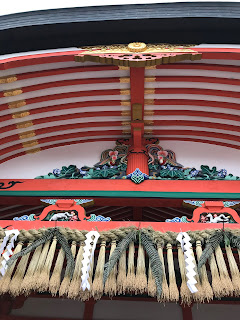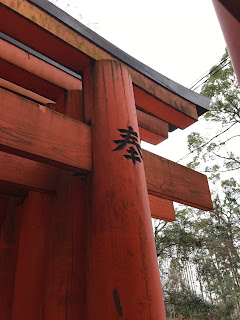When someone thinks of Japan, images of bright orange shrines often come to mind. It is a very popular image. However, it is not typically an accurate image. Just like Greece is not filled with white buildings featuring blue windowsills, the majority of Japan's shrines are not decked out in orange.
Kyoto, the cultural capital of Japan, is a different story. The city is filled with the iconic bright vermillion decorated temples and shrines. (The official color is vermillion, not orange.) The color represents the power of Inari Okami (the god of harvest), a popular god in Kyoto. It is so iconic that the city has regulations prohibiting buildings and signs from being too gaudy and clashing with Kyoto's shrines. Nothing can even come close to distracting from the official color of the shrines, or traditional and historical landscapes. For example, McDonalds famous bright yellow arches with red background sign is lighter yellow with a sober brown background in Kyoto.
The purpose of our trip was to go to Miwa Shrine and the Kyoto Railway Museum. Everything else was icing on the cake. Our Shinkansen tickets were for the 2 pm train, so we had several hours to spend wandering around the city before we needed to be at the station. We decided to visit two famous shrines: Fushimi Inari Taisha Shrine and Yasaka Shrine. (I'll talk about Yasaka Shrine in another post.)
Fushimi Inari Taisha Shrine is commonly known as the shrine with 10,000 torii gates. When first walking up to it, it seems like a beautiful, but not remarkable in any way. What was remarkable was the number of people there. This really was one of the major tourist destinations. There were so many languages and countries represented in the attendees. I overheard one man say to another when he heard my husband speaking Japanese to our son "Japanese people do come here, too."
Right away we noticed all the fox statues around the shrine. Usually there are dog statues at the entrance of shrines, but this one had foxes. The fox is the god of harvest's servant. It brings the prayers and wishes of the people to the god, Inari Okami.
After looking at a map, we saw that the famous toriis were up a short hill. The Senbon Torii (1,000 shrine gates) were an amazing sight. Torii after torii were aligned inches from each other. We stepped to the side to let the herds of people pass by, waiting for a break in the crowds. There were two rows of toriis, with a sign indicating one was for walking up and the other for returning to the main shrine.
After walking through the 1,000 toriis, we came to the Inner Shrine. Behind it was the Omokaru Stone. Leading up to the stone was a line of people, waiting to lift the stone. When it was their turn, the person would bow twice, clap twice, say their wish, and try to lift the stone. If the Omokaru Stone felt heavy, their wish was going to take a long time or work in order to come true. But, if the stone felt light, their wish would come true quickly. When I picked up the stone, it felt pretty heavy. I guess I have some work to do to make it come true!
We knew that if we were going to see Yasaka Shrine, we needed to continue on our way. There is a whole trail going up the mountain that takes about 2 hours to hike with lots more toriis. I think if we were visiting in the spring or fall, we would have made the time to do the loop. But since it was so cold, we were fine with skipping it.
I'm so glad we took the time to visit this very popular shrine. It is very beautiful and so different that most of the shrines I have ever been to in Japan.
In 2017 my family headed to Tokyo. My husband had a new job and my son and I came along for the ride. This move was my second move to Japan - the first was for a year in 2002. At that time I was a single, recent college graduate. Moving abroad as a family was a whole different ball of wax. As I live this crazy life in Japan, I track our adventures and my observations, creating an unofficial guidebook to the city.
Subscribe to:
Post Comments (Atom)
The time has come to say goodbye
Earlier this year my husband applied for a new job. As usual, I encouraged him as he went through the interview process. It was a long, draw...

-
I need to renew my passport. It is hard to believe that another 10 years have passed and it is time to get a new book that travels around t...
-
I was able to take a bit of time for myself today and join a group chat of moms. While my husband worked and my son watched a couple episod...




















No comments:
Post a Comment